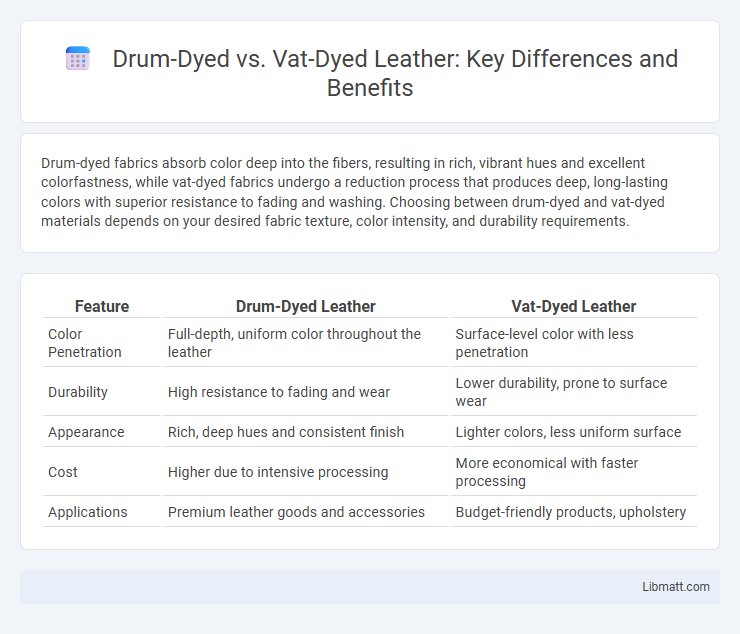Drum-dyed fabrics absorb color deep into the fibers, resulting in rich, vibrant hues and excellent colorfastness, while vat-dyed fabrics undergo a reduction process that produces deep, long-lasting colors with superior resistance to fading and washing. Choosing between drum-dyed and vat-dyed materials depends on your desired fabric texture, color intensity, and durability requirements.
Table of Comparison
| Feature | Drum-Dyed Leather | Vat-Dyed Leather |
|---|---|---|
| Color Penetration | Full-depth, uniform color throughout the leather | Surface-level color with less penetration |
| Durability | High resistance to fading and wear | Lower durability, prone to surface wear |
| Appearance | Rich, deep hues and consistent finish | Lighter colors, less uniform surface |
| Cost | Higher due to intensive processing | More economical with faster processing |
| Applications | Premium leather goods and accessories | Budget-friendly products, upholstery |
Introduction to Dyeing Techniques
Drum-dyed fabric undergoes dyeing in a rotating drum, allowing deep color penetration and uniform shade across fibers, ideal for synthetic and blended textiles. Vat-dyed fabric is immersed in a dye bath containing insoluble dyes reduced to a soluble form, then oxidized back to insoluble, offering exceptional colorfastness primarily for cellulosic fibers like cotton. Both techniques enhance fabric durability and color richness but differ in process complexity and ideal material applications.
What is Drum-Dyed Leather?
Drum-dyed leather is a type of leather that undergoes a dyeing process inside a rotating drum, allowing the dye to penetrate deeply and evenly into the hide. This method ensures rich, consistent color and enhances the leather's durability by reducing surface wear and fading. If you seek long-lasting color retention and a uniform appearance, drum-dyed leather offers superior quality compared to other dyeing techniques like vat-dyed leather.
What is Vat-Dyed Leather?
Vat-dyed leather undergoes a dyeing process where the material is submerged in a liquid dye solution, allowing the color to penetrate deeply throughout its fibers for uniform and long-lasting coloration. This technique ensures excellent colorfastness and resistance to fading, making vat-dyed leather ideal for products that require durability and consistent appearance over time. Your choice of vat-dyed leather guarantees a rich, vibrant finish that maintains its quality even with heavy use.
The Drum-Dyeing Process Explained
Drum-dyeing involves placing fabric or yarn into a large rotating drum where dye is evenly distributed under controlled temperature and pressure, ensuring deep penetration and vibrant color consistency. This process is especially effective for producing rich, uniform shades on synthetic and natural fibers, enhancing durability and colorfastness compared to vat-dyeing. Understanding drum-dyeing allows you to select textiles that maintain vivid hues and resist fading even after repeated washing.
The Vat-Dyeing Process Explained
The vat-dyeing process involves immersing fabric in a vat containing a reduced, water-insoluble dye that becomes soluble upon chemical treatment, allowing deep penetration into the fibers for rich, long-lasting colors. You can expect superior colorfastness and resistance to fading with vat-dyed materials due to the dye's unique ability to bond tightly within the fabric structure. This method is commonly used for cellulosic fibers like cotton, making vat-dyed products ideal for durable textiles needing vibrant, enduring hues.
Color Depth and Consistency Comparison
Drum-dyed fabrics exhibit superior color depth, as the dye penetrates fibers more thoroughly, resulting in richer and more vivid hues compared to vat-dyed textiles. Vat-dyed materials often show slight color variations due to the dyeing process, which can affect consistency across large batches. For your projects demanding uniformity and intense colors, drum-dyeing provides enhanced reliability in both color depth and consistency.
Durability and Wear Resistance
Drum-dyed fabrics exhibit superior durability and wear resistance due to the dye penetrating deeply into the fibers, which minimizes fading and color loss over time. Vat-dyed materials are also highly durable, known for their excellent resistance to washing and abrasion, making them ideal for heavy-use applications. Your choice between drum-dyed and vat-dyed textiles should consider the specific wear environment to maximize longevity and maintain vibrant color.
Environmental Impact of Each Method
Drum-dyed fabric uses significantly less water and energy compared to vat-dyed fabric, making it a more sustainable option for eco-conscious consumers. Vat dyeing typically involves prolonged immersion and higher temperatures, resulting in increased chemical runoff and environmental pollution. Your choice of drum-dyed textiles helps reduce waste and supports responsible water management in the dyeing process.
Cost and Production Considerations
Drum-dyed fabrics generally incur higher costs due to longer processing times and increased energy consumption compared to vat-dyed methods, which are more cost-effective for large-scale production. Production considerations highlight drum-dyeing's suitability for small batches and specialized color effects, whereas vat-dyeing excels in efficiency and colorfastness for mass production. Manufacturers weigh these factors to balance budget constraints with desired fabric quality and color durability.
Choosing Between Drum-Dyed and Vat-Dyed
Choosing between drum-dyed and vat-dyed fabrics depends on your preferences for colorfastness, vibrancy, and environmental impact. Drum-dyed textiles offer deeper penetration of color, resulting in more vibrant and long-lasting hues, while vat-dyed fabrics excel in producing colorfast, fade-resistant materials. Considering your fabric's end use and desired durability will help you select the appropriate dyeing method to meet your needs.
Drum-dyed vs vat-dyed Infographic

 libmatt.com
libmatt.com